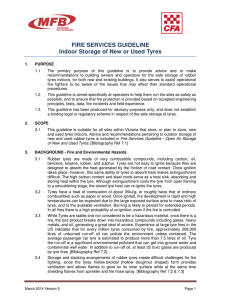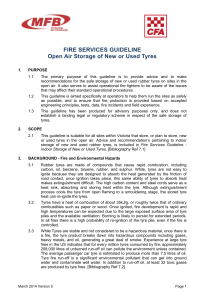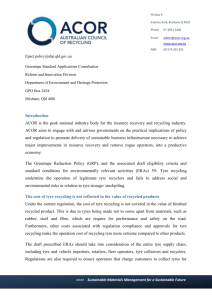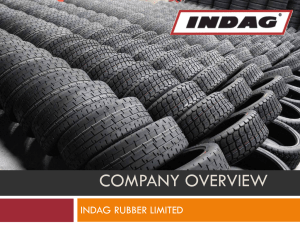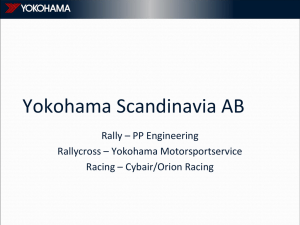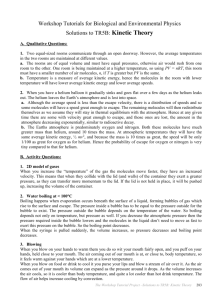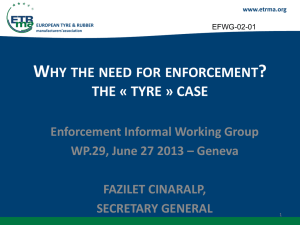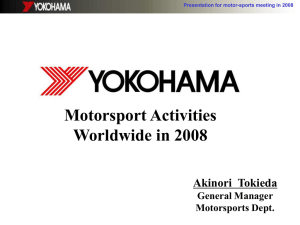Text version (WORD 600k)
advertisement
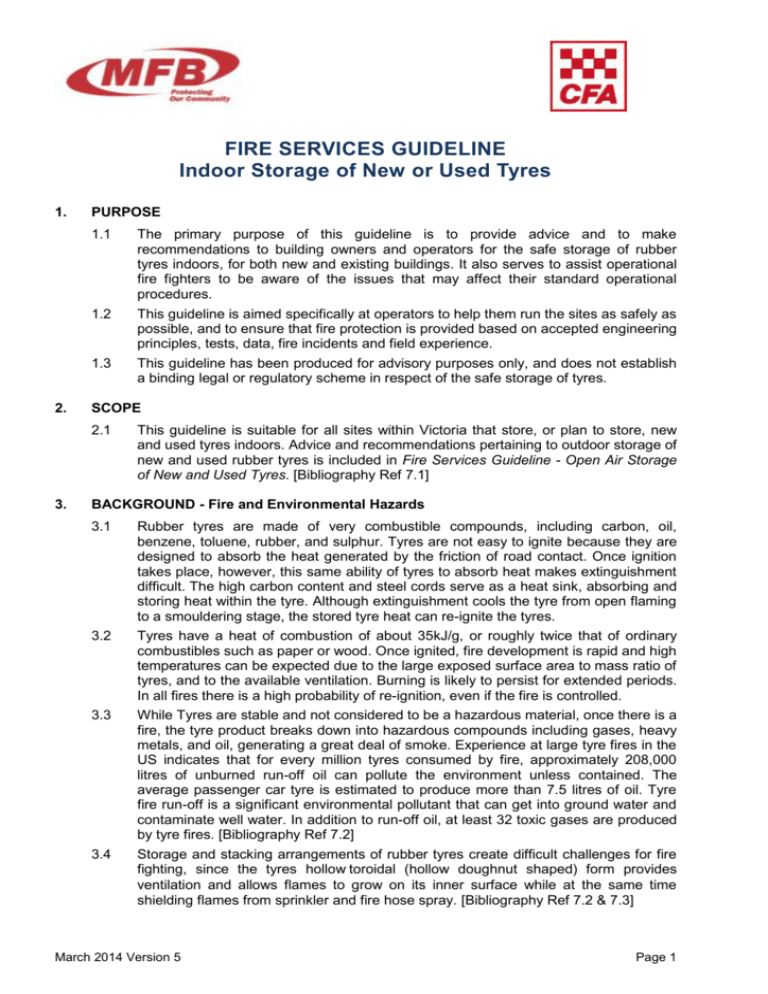
FIRE SERVICES GUIDELINE Indoor Storage of New or Used Tyres 1. 2. PURPOSE 1.1 The primary purpose of this guideline is to provide advice and to make recommendations to building owners and operators for the safe storage of rubber tyres indoors, for both new and existing buildings. It also serves to assist operational fire fighters to be aware of the issues that may affect their standard operational procedures. 1.2 This guideline is aimed specifically at operators to help them run the sites as safely as possible, and to ensure that fire protection is provided based on accepted engineering principles, tests, data, fire incidents and field experience. 1.3 This guideline has been produced for advisory purposes only, and does not establish a binding legal or regulatory scheme in respect of the safe storage of tyres. SCOPE 2.1 3. This guideline is suitable for all sites within Victoria that store, or plan to store, new and used tyres indoors. Advice and recommendations pertaining to outdoor storage of new and used rubber tyres is included in Fire Services Guideline - Open Air Storage of New and Used Tyres. [Bibliography Ref 7.1] BACKGROUND - Fire and Environmental Hazards 3.1 Rubber tyres are made of very combustible compounds, including carbon, oil, benzene, toluene, rubber, and sulphur. Tyres are not easy to ignite because they are designed to absorb the heat generated by the friction of road contact. Once ignition takes place, however, this same ability of tyres to absorb heat makes extinguishment difficult. The high carbon content and steel cords serve as a heat sink, absorbing and storing heat within the tyre. Although extinguishment cools the tyre from open flaming to a smouldering stage, the stored tyre heat can re-ignite the tyres. 3.2 Tyres have a heat of combustion of about 35kJ/g, or roughly twice that of ordinary combustibles such as paper or wood. Once ignited, fire development is rapid and high temperatures can be expected due to the large exposed surface area to mass ratio of tyres, and to the available ventilation. Burning is likely to persist for extended periods. In all fires there is a high probability of re-ignition, even if the fire is controlled. 3.3 While Tyres are stable and not considered to be a hazardous material, once there is a fire, the tyre product breaks down into hazardous compounds including gases, heavy metals, and oil, generating a great deal of smoke. Experience at large tyre fires in the US indicates that for every million tyres consumed by fire, approximately 208,000 litres of unburned run-off oil can pollute the environment unless contained. The average passenger car tyre is estimated to produce more than 7.5 litres of oil. Tyre fire run-off is a significant environmental pollutant that can get into ground water and contaminate well water. In addition to run-off oil, at least 32 toxic gases are produced by tyre fires. [Bibliography Ref 7.2] 3.4 Storage and stacking arrangements of rubber tyres create difficult challenges for fire fighting, since the tyres hollow toroidal (hollow doughnut shaped) form provides ventilation and allows flames to grow on its inner surface while at the same time shielding flames from sprinkler and fire hose spray. [Bibliography Ref 7.2 & 7.3] March 2014 Version 5 Page 1 3.5 4. FM Global Research fire tests have indicated that properly designed sprinkler systems can control a fire in tyre storage, but manual fire fighting may be necessary for complete extinguishment. An understanding of the behaviour of tyre storage fires is therefore essential if a fire under control is to be completely extinguished by responding fire fighters. Due to the hazardous conditions present in developed fires involving rubber tyres, it is not intended that fire beyond the incipient stage be fought by anyone other than trained fire fighters. Refer to Appendix 1, Tyre Storage Fire Behaviour - Firefighting. [Bibliography Ref 7.2 & 7.3] PLANNING AND BUILDING DESIGN 4.1 Fire Protection 4.1.1 Operators should liaise with all relevant authorities and interested parties over proposals for new storage sites as part of the risk assessment process referred to in Section 5 below. These include: The Fire Services the Metropolitan Fire Brigade (MFB) or the Country Fire Authority (CFA) The appropriate Planning Authority (usually Local Council) The Environment Protection Authority (EPA) WorkSafe Victoria 4.1.2 Given the hazardous conditions present in rubber tyre fires, in conjunction with the associated difficulties in fighting these fires, the Fire Services require that fire protection systems for storage of rubber tyres indoors should be assessed pursuant to Clause E1.10 of the Building Code of Australia. This means that a compliant sprinkler system may still be required even if the stored volume of tyres is less than the threshold defined for combustible goods in NCC BCA Volume 1 Vic Table E1.5 Requirements for Sprinklers. 4.1.3 The fire services consider that indoor tyre storage facilities should be protected in accordance with Clause 11.7.2 of AS2118.1-2006 as amended. [BibliographyRef 7.5]. 4.1.4 An allowance should be made for a minimum of three hydrant hose streams to allow extinguishment of any sprinkler controlled fire. Hydrants should meet the requirements of AS2419 – 2005 as amended. It is strongly recommend that water flow rate of each hydrant be based on a minimum flow rate of 10 l/s per hydrant, regardless if they are fed from a pumped system or not. 4.1.5 The design demand for the fire protection system should include the sprinkler demand plus the hydrant hose streams allowance referred to above. 4.1.6 Essential Safety Measures (ESMs) for the building should be maintained in accordance with the Victorian Building Regulations 2006. 4.2 Water Supplies 4.2.1 It is recommended that a water supply duration of 4 hours is provided, with reference to Table 11.8.3 of AS2118.1-2006 as amended. This water supply should allow for simultaneous flow of both sprinklers and hydrants as noted above. 4.2.2 Water provided for fire systems should be potable or Class A recycled water and should be salt free, due to the production of dioxins. [Bibliography Ref 7.7] 4.3 Smoke and Heat Vents / Exhaust 4.3.1 Where smoke and heat vents / exhaust are required to be installed, the fire services consider they should be arranged for manual operation by the attending fire service after the fire is controlled by the sprinkler system. [Refer to Appendix 1]. The designers should liaise with the relevant fire services on this issue as part of the risk assessment process referred to in Section 5 of this Guideline. March 2014 Version 5 Page 2 4.4 Ignition Source Control 4.4.1 It is recommended that operators develop and document procedures to control possible ignition sources on site, which should include as a minimum: A hot work permit procedure for all cutting, welding, grinding type activities Regular inspection and repair of electrical equipment, vehicles, machinery, security fences, etc. Restriction of smoking to designated areas No open fires No storage of other flammable or combustible materials, hazardous materials or other easily ignitable material within 30m of any tyre storage. Maintain separation distances to buildings and boundaries. 4.5 Site Containment of Contaminated Firewater, oil and liquid by-products of combustion 4.5.1 Bund walls or catchment pits should be provided to contain surface run off from the site during fire fighting activities. The containment capacity should be determined as part of a site fire risk assessment, and in conjunction with the Fire Services. 4.6 Access for Fire Services appliances 4.6.1 Access for emergency vehicles should be provided as detailed in Fire Services Safety Guidelines. [Bibliography Ref 7.8 and 7.9] 5. 6. FIRE RISK ASSESMENT 5.1 A fire risk assessment should be performed which will determine all fire hazards at the site, determine the likelihood that a fire will occur, then determine the consequences of the nominated fire incidents, in terms of life safety, property protection and the environment. 5.2 The fire risk assessment will determine all the resources and equipment required to manage the consequences of the identified fire scenarios. The fire risk assessment should be performed in consultation with the relevant fire authority. 5.3 It is expected that, depending on site conditions, equipment available, emergency response procedures, available staff and level of training, etc, the fire risk assessment may require appropriate fire modelling and emission and dispersion modelling to determine possible off site extents of toxic products of combustion. EMERGENCY PREPAREDNESS 6.1 Emergency Plan 6.1.1 Operators should develop and document an emergency plan which includes all the matters contained in Appendix 2, which has been developed with reference to Bibliography Ref 7.10. 6.1.2 It is recommended that operators develop and document a tactical fire plan for the site that includes: Location of fire hydrants, boosters, fire service tapping(s), sprinkler control valves fire pumps, static water tanks, etc Location of all first aid fire fighting equipment, including the location and quantity of any stocks of Class A and Class B foam concentrate held Fire fighting actions appropriate to the site Control of fire fighting run off Location of drains, isolation valves, etc Location of access points to the site Location of hazardous materials or dangerous goods stored on site Deployment procedures for fork lift trucks, operators, etc. March 2014 Version 5 Page 3 6.2 Emergency Procedures 6.2.1 Emergency procedures should be developed to cover all foreseeable emergencies for the site. 6.2.2 Emergency response procedures developed by the operator should include the use of fork lift trucks or other means to remove tyres from the fire area. This may be necessary to ensure complete extinguishment of tyres. Operators should also ensure that an appropriate number of trained equipment operators with the required personal protective equipment (PPE) are available to operate the fork lift trucks. Fire Services personnel will not operate fork lift trucks, or provide PPE for operators of facility fork lift trucks. 6.2.3 The emergency procedures should include, as a minimum: The means of raising the alarm in the event of an emergency Safe evacuation and accounting for personnel Details of isolation points for essential services Containment of any incident Decontamination following an incident Contact details of the emergency services, the EPA, etc Actions to be taken by employees in the event of an emergency Deployment procedures for fork lifts, operators, etc. The operator’s expectation of actions by the Fire Services 6.3 Emergency Equipment 6.3.1 The operator should determine equipment required to contain and manage emergency incidents. For indoor tyre storage sites this would include equipment such as forklifts, etc, which may be required to remove tyres from the storage for complete extinguishment. 6.3.2 For equipment that is not always available on site, appropriate arrangements should be in place with equipment suppliers and operators, with appropriate deployment procedures developed. 6.3.3 Operators of fork lift equipment should be trained in the use of Self Contained Breathing Apparatus (SCBA), and operators should ensure that sufficient SCBA equipment is available and maintained at all times. Fire Services personnel will not operate fork lifts. 6.3.4 All staff, including equipment providers and operators, should be appropriately trained in the site emergency plan and emergency response procedures. 7. BIBLIOGRAPHY Reference has been made to the following documents in preparation of this guideline: 7.1 Draft Fire Services Guideline – Open Air Storage of New and Used Tyres 7.2 Special Report: Scrap and Shredded Tire Fires, US Fire Administration/Technical Report Series, USFA-TR-093/December 1998 7.3 FM Global Property Loss Data Sheet 8-3, Rubber Tire Storage, January 2009. 7.4 NFPA 13: Standard for the installation of sprinkler systems 2013, Chapter 18 7.5 7.6 AS 2118.1-2006 Automatic Fire Sprinkler Systems, Part 1 General Systems AS2419.1-2005 Fire Hydrant Systems – System Design, Installation and Commissioning 7.7 Fire Safety for Tyre Sites, Home Office/The Scottish Office, 1995 7.8 CFA Guidelines for Subdivision Planning, available at http://www.cfa.vic.gov.au/planprepare/subdivision/ 7.9 MFB Guideline GL-13, Hardstand and Emergency Vehicle Access for Fighting Appliances, 12 August 2008, and MFB Guideline GL-27, Planning Guidelines for March 2014 Version 5 Page 4 Emergency Vehicle Access and Minimum Water Supplies within the Metropolitan Fire District, 14 April 2009 (available at http://www.mfb.vic.gov.au/CommunitySafety/Workplace/Fire-Safety-Guidelines.html) 7.10 Dangerous Goods Act 1985, Code of Practice for the Storage and Handling of Dangerous Goods, 2013, WorkSafe Victoria 7.11 FM Global Property Loss Data Sheet 1-10, Interaction of Sprinklers, Smoke and Heat Vents, and Draft Curtains, January 2011 7.12 GL 013, General Guidelines for the Outdoor Storage of Used Tyres, Amendment A, 28 December 2005, South Australian Fire Services 7.13 Policy No 2, Guidelines for Bulk Storage of Rubber Tyres, Version 1.01, 21 April 2008, Structural Fire Safety Unit, NSW Fire Brigades March 2014 Version 5 Page 5 Appendix 1 Tyre Storage Fire Behaviour – Fire fighting [From Bibliography Ref 7.3] C.1 Incipient Stage If discovered in the early stages, the fire can be effectively extinguished with manual protection. Dry-chemical extinguishers are effective because the powder can pass into the mass of tyres and control the fire temporarily. However, it is necessary to back up extinguishers with small hose, and to remove burning tyres from the pile. Removed tyres should be taken outdoors away from other combustibles and thoroughly wetted down. The area in which the fire occurred should be constantly attended for several hours to watch for rekindling. Automatic sprinklers usually operate within two to five minutes of ignition. At this point, extinguishers are not generally effective. Because of smoke, the area becomes increasingly obscured and untenable. C.2 Active Stage At this point, because of poor visibility in the building, the ability to use hose streams effectively is questionable. Sprinklers should be allowed to operate until control of the fire is obtained. During this period, the building is best left unventilated. As control of the fire is gained, smoke will tend to change from black to grey and will diminish in intensity. Charged 1-1/2 in. (38 mm) hose lines should be laid out prior to entering the building for overhaul. Portable flood lights, self-contained breathing apparatus, personal protective gear, etc., should be assembled for the crew. C.3 Critical Stage After 60 to 90 minutes, when smoke intensity should have diminished, the building should be ventilated around the periphery of the suspected fire location. Close observation should be made of smoke conditions. If smoke generation increases, cease ventilating and close up the building if possible. Sprinklers should remain in operation during the critical stage. C.4 Overhaul As soon as smoke clears enough to permit entry, the building should be entered, with small hose streams directed into burning tyres. Sprinklers should remain in operation until the fire chief is certain that the fire is small enough to be extinguished by hose streams. Any sprinkler control valve that is shut off should be manned during the entire period of closure, to enable prompt reopening of the valve, if needed. Fork trucks and other means should be employed to remove tyres from the fire area. It will be necessary to keep sprinklers or hose streams in operation during this procedure at least until evidence of flame is gone. The fire area should be patrolled for 24 hours following the fire. March 2014 Version 5 Page 6 Appendix 2 Emergency Plan Content [From Bibliography Ref 7.10] – The Emergency Plan should include the following: 1 Name, location, postal address and nature of operations 2 Detailed map of the facility and surrounding area detail 3 Inventory of stored materials 4 Min & Max number of persons expected at the facility 5 Infrastructure likely to be affected by an incident and details of possible off site impacts on neighbours, including residential, commercial and industrial premises 6 Emergency Planning assumptions 7 Description of measures to control the consequences of each hazard and major incident 8 Details of emergency contact personnel 9 Allocation of personnel for implementing the plan 10 Arrangements for mutual aid between adjacent facilities 11 Procedures for early warning to the emergency services of an incident 12 Details of on-site and off-site warning systems 13 Contact details for emergency services 14 Details of on-site communication systems 15 Details of emergency resources on site 16 Arrangement for obtaining additional external resources 17 Procedures for safe evacuation and muster of personnel 18 Details of control points and procedures for essential services 19 Procedures for containment of any incident 20 Procedures for decontamination following an incident March 2014 Version 5 Page 7
